Writing the book on Bessborough
A senior researcher from the Commission of Investigation into Mother and Baby Homes has written his own book about Bessborough in Cork, but can the full truth ever really be unearthed?
It seems like an allegory for the whole sorry tale.
If you approach Bessborough folly by an unofficial route, past broken security gates affixed with planning notices and down a tarmac road now overgrown with moss, you arrive at the trash heaps.
Next to the roar of the Mahon ring road, within sight of the back of Mahon Retail Park, you can make out the castle-like folly through a tangled thicket. There’s a ragged hole in some chain-link fence. People clearly do use this way to gain access to the monument that has come to be so contested, to mean so much to so many.
There are piles of rubbish, smashed TVs, weathered sofas pulled up alongside the remnants of fires. It’s a sorry and bewildering sight, all this detritus. A confusing and tragic mess.
I’ve come the wrong way, clearly. I turn back.
Out on the road, historian Michael Dwyer pulls up in his car.
“I’d usually just go through the main entrance,” he says, and so we set off for the main gates of the Sacred Heart Convent, up a sweeping driveway, past lawns, to park alongside the official entrance to the folly.
We walk down an avenue of trees: it’s a little unkempt, but it’s serene and peaceful.
For some of the families of the 923 babies that are reported to have died at Bessborough in the 76 years in which it was a Mother and Baby Home operated by the Sisters of the Sacred Hearts, between 1922 and 1998, Bessborough folly has become a place of commemoration.
Even though it’s far from clear if this is the final resting place of the infants who died in the home.
Michael doesn’t believe most of the babies recorded as having died at Bessborough are buried here at all.
“From the documentary evidence, every single burial we have found has been off-site, with the exception of one burial of a child, who was buried with the permission of the nuns,” he says, hands in pockets, looking sombrely around at the small plot behind the folly, where there are grave markers for the nuns who died here, and several commemorative plaques.
The historian
We came in to the site the official way, and Michael Dwyer is used to the official route: for nearly six years, he worked as a senior researcher for the Mother and Baby Homes Commission. Now, he’s self-published a book based on his research, Bessborough: History & Controversy.
A former history lecturer at UCC, Michael worked for the Department of Children, Equality, Disability, Integration and Youth from June 2015 to February 2021, unearthing records on Mother and Baby homes.
He was also responsible for making extractions of transcripts of testimonies given by survivors to the investigative commission under oath, from Bessborough and two other homes, Castlepollard in Co Westmeath and Sean Ross in Co Tipperary.
We walk around the folly, both inside the nun’s burial ground and outside, within an area that some still believe may contain the remains of babies, an area that was once marked on a map as having contained a children’s burial ground.
It’s hard not to tread with caution in this wooded area. Is it possible that there are still remains here?
“See this mound here?” Michael says, pointing. “We were here for a week, and they searched everything that looked like anything. All of this ground is highly disturbed, the landscaper said that. There’s this bank of trees, there used to be a water feature, apparently a man-made lake that had been dug up.”
“The archaeologists looked in a lot of different areas: the city archaeologist was down a couple of years back and dug some trenches, and separately the developer dug six trenches. They found nothing.”
Instead, Michael believes that it was common practice for these babies of unwed mothers to be placed into coffins alongside adult remains in different cemeteries, most notably on Carr’s Hill, where the HSE used to operate a “pauper’s” graveyard.
The situation is not a straightforward one: some babies died in Bessborough Home and some in the maternity hospital which was on site, but others were transferred to the Cork District Hospital, St Finbarr’s, and died there.
“We were looking for certain records from St Finbarr’s and a guy rang up 96fm and said he remembers babies being put into the coffins of adults,” Michael says. “We didn’t find documentary evidence of that, and he didn’t make contact with the commission or give testimony.”
“But the former director of St Finbarr’s Hospital, I manage to track him down, he was still alive. He was profoundly deaf but completely compus mentis and I met himself and his wife and he told me about the records that were created by what they called ‘the mortuary man.’ They were small cards, like rolodex cards, on every body that went through the mortuary, so we went looking for those.”
Eventually, Michael uncovered a batch of records in Cork University Maternity Hospital (CUMH), mostly dating to the seventies.
“This was one of the most important documents we found,” he says, taking out his phone. He shows me a picture: it’s a card with the name of the occupant of the adult coffin, and alongside it, it says ‘with infant…’ and then a surname.
“We found a whole box of these from the seventies, for St Michael’s cemetery,” Michael says. “This one, for example, was buried with someone’s limb.”
Baby William
Inside the nun’s burial ground there is one very sad plaque indeed, to William Gerard Walsh, who was born on October 26 1960 and died on December 2 1960. We now know that William’s remains are elsewhere. And it was Michael who found out.
In the Bessborough records, Michael found a letter to Sister Sarto, the erstwhile Mother Superior of Bessborough, from an administrator at St Finbarr’s, confirming that their records showed that baby William had been buried at the pauper’s graveyard in Carr’s Hill. That letter was dated December 12, 1994.
In the spring of 1995, baby William’s mother, Bridget, returned to Bessborough for the first time since she left it following his birth. She wanted to know where her baby was buried. She had phoned Sr Sarto in the winter of 1994, presumably precipitating the Mother Superior’s queries to St Finbarr’s.
Although she had received the letter with William’s whereabouts months earlier, Sr Sarto led Bridget to the area next to the nun’s plot behind the folly, tapped the ground with her foot, and indicated that this was where her baby was buried.
“It wasn’t until after the Tuam story broke in 2015 that my mum put a plaque in there, just to mark it, because she knew they wouldn’t dare refuse it,” Bridget’s daughter Carmel Cantwell says. “Bessborough was the last place she saw her baby alive. We started commemorations in 2014 and we still do them every year.”
Carmel had begun to doubt that her brother’s remains were in the spot indicated by Sr Sarto but it wasn’t until 2019 that the family could officially confirm what the nuns had known since December 1994.
Bridget
Bridget’s story is recounted in the Mother and Baby Homes Commission report. She has also shared her story with newspapers, although these days she’d rather not do any more talking.
“My mum gets so traumatised talking about it, and she just can’t do it, so I’ve kind of carried on being her advocate,” Carmel says.
Bridget was 17 when she got pregnant. She became ill shortly after giving birth to William in Bessborough, developing a large abscess on the site of an injection that nuns gave her while she was in labour. As her own condition worsened, although he had been born healthy and had been feeding well, William got sick too.
“She says that from that day on, she was begging with them to get him help.” But Bridget says that neither she nor her baby were treated. They were separated, William transferred to a sick bay that the girls in the institution told Bridget was called “the dying room.” Bridget was brought up to feed him in a draughty corridor.
William was eventually transferred to St Finbarr’s, where he died. A brusque doctor eventually lanced Bridget’s abscess, but only when it reached a stage that her ability to walk had been affected by it and she had become lame.
When Bridget left the hospital, she was told that William had already been buried. But three years ago, they discovered that this was not true: his little body had remained in the mortuary of St Finbarr’s for 11 days. Bridget had been robbed of the closure of a burial.
Bridget moved back to London after Bessborough, but the trauma of her experience lived on. She spent six months in a psychiatric ward, made three attempts on her own life. It wasn’t until her daughter Carmel, who grew up in London, coincidentally married a Cork man and moved to an address near Bessborough that Bridget set about trying to heal the past.
Carmel has been reading Michael’s book: she takes issue with some elements of it, and was not delighted to read her mother’s testimony included in his book without him having contacted her, but says it “reads well compared to the commission report.”
“Some of it is very useful information,” she says. “For example, that they started using antibiotics in the 1940s. I didn’t know that. My mum says she wasn’t given any treatment, and that was in 1960.”
The fact that Michael has accessed such detailed records when it comes to the treatment of some babies leaves questions for Carmel, who does not believe the record regarding her mother and brother’s time at Bessborough is complete.
“It’s strange to me that in Michael’s book there are records from 1946, detailed records, literally times of day, and how the baby was, and what was given. In the forties. But none of that in 1960 for my mother.”
“I’ve even seen a baby who was there at the exact same time as William with a full record, a feeding chart, how much weight he gained, what food he was given. And that’s not there for my brother. So I don’t know why those records have disappeared. And for my mother as well. On her information it says, ‘condition on discharge: good.’ She left with packing in the wound on her backside that took nearly a year to heal, that she had to look after herself. She had lost so much weight that none of her clothes fit her.”
And Carmel doesn’t believe that Michael is without his own bias: she says he only worked with a small selection of testimonies in his book, that he omitted instances where the nuns are known to have lied.
Knowledge is power
The Bessborough story is still very much alive: just two weeks ago, Cork City Council turned down planning permission for developers MWB Two to build 92 apartments on the site, following on from an earlier rejected planning application for 179 apartments that families were concerned would impinge on potential unrecorded burial sites.
This week, Micheál Martin has defended the terms of the redress scheme that has resulted from the Commission of Inquiry into Mother and Baby Homes, the limits of which have left many survivors furious: only babies who were in the institutions for more than six months will be eligible for redress, which leaves out 40% of survivors.
Bridget would be eligible for redress, but she doesn’t want money. The truth is the only thing that matters to her, Carmel says: “Her redress would be for the state to acknowledge that her baby was neglected and that if he had medical care sooner, he may have lived.”
The entire process of the Commission of Inquiry into Mother and Baby Homes has been riddled with controversy. The manner in which testimony was gathered from survivors in two separate committees, one legally binding and one not, the lack of access to all the records and documents the commission used: so much of the hurt of the process has come from lack of access to knowledge, to how some information was disclosed and some had to be fought for.
When the state moved to seal 60,000 Mother and Baby Home documents relating to the work of the commission for 30 years, it seemed to compound the hurt, mistrust and imbalance of power for many. These records are now held by Tusla.
Knowledge is power.
For Carmel’s mum, there have been several instances where there has been an enormous imbalance of power when it comes to who has the information and who hasn’t. Because she named members of the Sacred Heart holy order in her testimony, the nuns were provided a transcript of what she said, but she was not allowed a transcript herself even though she was identifiable from the details in her testimony.
When her testimony was later published, she disputed a one-word change to her account: when Sr Sarto took her to the folly, Bridget says she said that this was where her baby was buried.
“The word ‘believed’ was put in,” Carmel says. “The version that was published says that Sr Sarto said she believed that William was buried there. That’s only a little difference but it casts the whole thing in a different light.”

The state later acknowledged in a High Court action that it had wronged Bridget and eight other women, who should have been able to have a copy of their transcripts. Another imbalance of power.
Carmel also says that her mum only finally found out where William was buried when an interim report into burials was published by the commission in 2019.
“We recognised William because he was the only baby that died in December 1960, and we read that he was buried in Carr’s Hill,” she says. “It was an awful, awful shock: My mum had already been to the commission and she just couldn’t believe that they’d let her find out like that.”
Michael says he’s mystified by this, that when he found the letter regarding baby William’s place of burial, the commissioners agreed that Bridget’s family should be notified as soon as possible.
Knowledge is power. And it was the people with the power who kept and controlled the records. Not the confused and bewildered young women and girls - 5% of Bessborough admissions were under 17 - who passed through.
For Carmel, this is self-evident: she says her mother has commented on how the official record does not reflect her lived experience of Bessborough. For example, during Bridget’s illness, there’s an official record of a doctor and midwife being on duty at night. Bridget says that in reality, the medical staff all left at night and she was left to be looked after by other girls.
No-one wrote down cruel comments that were made to the girls, times when there were omissions of care, of who was feeling what.
The commission report, and Michael’s research, found no documented evidence that suggested girls were incarcerated against their will, for example. Despite the testimony of young women who felt powerless to leave.
“They took my mum’s clothes and savings book and gave her a uniform and these clogs that you really couldn’t have gotten far in,” Carmel says. “What could she do? She thought the door was locked. Now, she never went up and tried the door, because she was so fearful. There’s no record of those things.”
Like the story we started with, the official route into Bessborough is well-presented if imperfect; the unofficial, unseen route is distressing and ugly.
Setting the record straight
I ask Michael if he’s aware of the limits of the paper record: as a historian, he must rely on the written word. His book notes that in the late thirties, a Department of Local Government and Public Health report shows book-keeping, including death records, was lax and often incomplete at Bessborough in that period.
“I haven’t seen all the evidence: that’s what history is about,” he says. “You can establish a fact only with the available evidence. If new evidence presents itself, then it changes and progresses the conversation. As I say in the book, it’s not a solid block of immovable facts. It’s supposed to progress the conversation.”
Part of Michael’s motivation to write his book, he tells me, is to set the record straight as to his own body of work, his own years of painstaking and diligent research: ironically, amidst all the vocal criticism of the Commission’s work, he has sometimes felt powerless too.
“The main reason I wrote the book is to take ownership of the research,” he says “The commission, or any commission, is such an easy target for anyone to say whatever they want about the level of research, the findings, and there’s no-one there to rebut it.”
“To be honest, I don’t care if I never sold a book: I didn’t do it to make money, I did it for posterity, that any serious person who is looking at this subject might pick up my book and say, these claims check out, and match up with the official records.”
Polarised
In his book, Michael is quite scathing about how some writers and reporters have covered Bessborough, saying his findings do not reflect the polarised narrative that has emerged in Ireland, where the nuns are cast as evil monsters and the role of families and partners - after all, for every baby there was a father - often diminished.
The polemic of some politicians has been unhelpful, he believes.
“Part of the problem is that there are a lot of careerists who drove the agenda, and the people driving a polarised narrative who were very slow to accept any other narrative,” he says.
“I remember when there were politicians shouting for the report to be dumped, and there were survivors going, ‘that’s not what we want, we want the recommendations of the report to be implemented, we want the redress and we want the whereabouts of the bodies investigated,’ and they were ignored.”
“The same women who gave testimony under oath, when you see their stories in the media, it seems to be radically different and I’m not saying that’s their fault. They could be being misrepresented. Do sober stories about Bessborough make front page news?”
His book certainly reveals this complex history when it comes to how Bessborough was founded in the early years of the state.
Orders of nuns had been asked to found Irish Mother and Baby Homes as an alternative to the workhouse, where pregnant women were mixed with mentally ill people, the destitute and people with a criminal history: they were founded to actually improve welfare.
The first Mother Superior of the home is on written record as saying “these girls are more sinned against than sinning,” and advocated for prosecutions in instances of statutory rape. In the early years of the state, before the catchnet of a social welfare system, they saw themselves as salvation for girls and babies who were cast out from their families and who faced a “depraved” existence.
The nuns themselves took no salary in that era, and were constantly up against the council asking for more money to run the home. Michael links the beginning of a horrendous rise in infant mortality at the home to a political decision made by the local authority to defund the provision of a doctor and midwife in 1937.
“The first half of this book is based solely on records held in the local archive in Blackpool,” he says. “I was perplexed because what I was finding was totally at odds with what I was reading in the newspapers.”
“People seem to be so unwilling to move away from the polemic, that it’s all about the nuns. And the Catholic Church did scar this country beyond belief. But if you use the church as a scapegoat for everything then you’re letting a lot of people off the hook.”
“It was a system, a state-sanctioned, society-approved system,” Michael says.
“The rhetoric around single women and their children even through the eighties and into the nineties was terrible, just terrible. Priests refusing to baptise children born out of wedlock went on into the nineties.”
A tangled web
Everything written here is just the tip of a miserable and complex iceberg. There are endless details, accounts that don’t quite match. Emotions run understandably high.
There are a great many details that won’t make it into this article. The amount of information is simply too great. Even a book can’t fully cover the whole story.
For Michael, working with a history within living memory is part of the complexity of the situation, and he knows that, even amongst survivors, there continue to be differences of opinion.
The final report of the commission, published in January 2021, was greeted with outrage by some survivors for its dispassionate conclusions, for the lack of culpability. Survivors wanted to be heard, respected, acknowledged. Like Bridget, they wanted accountability, apologies.
“As a subject matter, people tend to take ownership of it,” Michael says. “10,000 women and 10,000 babies went through Bessborough, so 20,000 people had an individual experience with that institution, and every one of those stories is valid. Two of my oldest friends have an association with Bessborough. There can’t be a family in Cork who isn’t in some way touched by it.”
Michael sent two copies of his book to the Cork Survivors and Supporters Association (CSSA) because he’s aware of the tensions around information, knowledge and testimony that have dogged the entire inquiry process.
“I told them I’d be happy for them to write a preface or a response,” he says. “They’re obviously not going to agree with everything in the book and that’s fine, and if they want to write a response, I can incorporate it into the book.”
“Because I self-published it, the book can become a living book: it can change and grow and new evidence can be added to it.”
Michael didn’t contact Carmel’s group, the Bessborough Mother and Baby Home Supporter Group, though, although he says he’d happily talk to them.
Not all Bessborough survivors agree: the CSSA have been campaigning for an area near Bessborough folly, the area marked as a children’s burial ground on an old map seen by the commission, to be preserved and recognised. But Carmel has launched her own call for a full investigation of the entirety of Bessborough: she believes that there are burial sites “at random” throughout the grounds.
And then there’s Michael, who doesn’t understand why more emphasis isn’t placed on investigating the five acre site at Carr’s Hill.
But everyone can agree on one thing: the reported death rate in Bessborough, as in many other Irish Mother and Baby Homes, as disputed and hard-to-come-by as it is, is a horrendous record.
The bodies
Here is a snapshot of the deaths that appeared in Department of Public Health reports over a twelve-year period, as reported in Michael’s book:
1932: 16 infant deaths
1933: 4 infant deaths
1934:30 infant deaths
1935: 39 infant deaths
1936: 25 infant deaths
1937: 22 infant deaths
1939: 38 infant deaths
1940-41: 38 infant deaths
March 1942 to July 1943: 32 infant deaths
1943: 70 infant deaths
1944: 102 infant deaths
There have been several theories as to the reason for these grotesque numbers, and Michael delves into some of them in his book. The use of untrained staff, low breastfeeding rates, a cohort of babies of potential poor outcomes in the first instance.
As Sr Sarto was also known to have noted, he believes the introduction of penicillin in the 1940s can be linked to the end of a period where babies’ deaths were being recorded at truly horrifying levels. In 1944, two babies died per week.
To Michael, one of the most horrifying things about this period was the apathetic attitude towards these deaths, not only within the holy order but from outside, from government and health officials.
“Every report from the Department of Local Government and Public Health just recorded the deaths on an annual basis without comment,” he says. “Absolutely no comment. Deaths amongst children born illegitimately were five times higher than for children born to married couples, but they weren’t deaths in the community. Those were institutional deaths.”
But by 1944, the death rate was so high that it began to be commented on: the state told the nuns that they would have to stop accepting new admissions. But while they did close to public patients, they kept the private fee-paying element in operation.
“At the peak in 1945, there was the perception that Bessborough was closed for a year, but they didn’t close it to private patients,” Michael says. “And the peak of infant mortality was in 1945, when 80% of the babies died. They were all unaccompanied children born to private patients.”
Doesn’t this death rate seem actually implausibly high, given that the private patients were those you could easily expect to have the best pregnancy outcomes? They were a wealthier demographic, better nourished, better educated?
“The children born to private patients were unaccompanied, that was the difference. At least the children born to public patients had the mothers there.”
Falsified death records a “conspiracy theory”
Michael knows what I’m getting at, and he doesn’t like it: in his book, he uses the words “conspiracy theory” when discussing the theory that death records were routinely falsified by nuns to facilitate illegal adoptions to the US.
Discrepancies between records kept by the nuns, figures reported to the Department of Public Health at the time, and those that appear in the General Register Office (GRO) have certainly not helped to dispel questions.
Former Irish Examiner reporter Conall Ó Fatharta was probably the journalist who delved the most into the minutiae of recorded deaths at Bessborough, and spent years using Freedom of Information and other tactics to try to gain access to records. Nuns reported 353 deaths of babies to the state up until 1953, but their own register showed 80 fewer deaths.
Michael says that Conall only ever saw incomplete records, that the on site maternity hospital kept a second death register that accounts for the disparity. This was a claim that was made to Conall too, but no second register has ever been uncovered.
Michael says his research for commission collated five different sets of records, and that he’s satisfied that the numbers add up.
“There are other institutional records that recorded deaths,” he says. “The indoor register, the baptismal records, which also recorded all the deaths, the GRO register. And they all matched up.”
To Michael, the records are the only thing he has to go on, and he has seen “absolutely no evidence” for falsified death records at Bessborough, he says. And he’s scathing of how the issue has been framed as the “sale” or human trafficking of children for profit.
“Look, there’s not one shred of evidence that any child was ever sold to America.”
Never mind that a report by a previous Special Rapporteur on Child Protection, Conor O’Mahony, concluded that the “obligation on the State to further investigate”suspicions of falsified deaths was clear.
Or that, despite there being no legal mechanism for adoption in Ireland until 1953, Archbishop McQuaid saw fit to circulate a letter to the homes in 1950 outlining the correct conditions for adoption to the US.

In all Michael’s years of investigating, he’s only been able to locate the burial places of just over 100 of Bessborough’s lost babies, though. Michael’s work with the commission reported death records of 923 babies. The General Register Office had records for 816. And the book in Bessborough home reported a figure smaller yet again.
No matter what you believe, there are somewhere between 700 and 800 lost babies, between 700 and 800 families left not knowing their whereabouts. And these are only the babies that were live births: stillbirths weren’t recorded at all.
And so we’ll finish near where we started, in the grounds of Bessborough home, wondering about where all these bodies are.
Back at the folly
There’s one other possible, but deeply upsetting, option: in his book, Michael mentions that in a detailed 1984 report on Bessborough, the social worker noted the practice of burning placentas in an on-site incinerator, indeed notes a pervasive odour from it. It is horrible to contemplate, but could it have been the practice to dispose of babies’ remains there too?
“That’s a concern,” Michael says, standing in the doorway of the folly. “It was a fact that it was in use: there was an incinerator in most hospitals. And the incinerator is a worry. But we don’t know where it was.”
CSSA have settled on a defined place of memorial at Bessborough, slightly to the north of the folly, and that's what some survivors and families want. But Carmel is not happy to let sleeping dogs lie. She wants to see Bessborough excavated, and by an independent team, too, unconnected to developers.
She points to the many - frequently discounted - accounts in existence of people saying they found bones, or even in one instance, a man who said he stumbled upon the burial place of several babies.
“I spoke to a man who was playing in 1948, running across the field. He explained to me that it was in line with the chapel, in a place you can’t access now because the nuns have built their new convent there, and the way he described it to me, he came across an open grave of three to four babies and then he was chased off. There’s another lady who said she saw a baby being buried in a different area in 1964.”
“I believe there are random burials all over Bessborough,” Carmel says. “We haven’t found one mass grave. Down by the waterline was notorious for bones coming to the surface. There was a pond, an icehouse, all these places should have been thoroughly investigated. There are lots of questions and to me, they need to be answered.”
“I want the children’s story told, because every baby has a story,” she says. “Like my brother. He would have been a great man, would have been a grandfather by now. Maybe we would have even known each other.”
“Every baby has a story.”

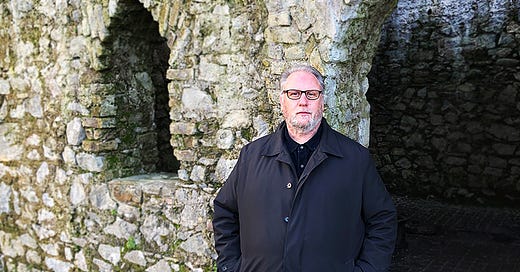


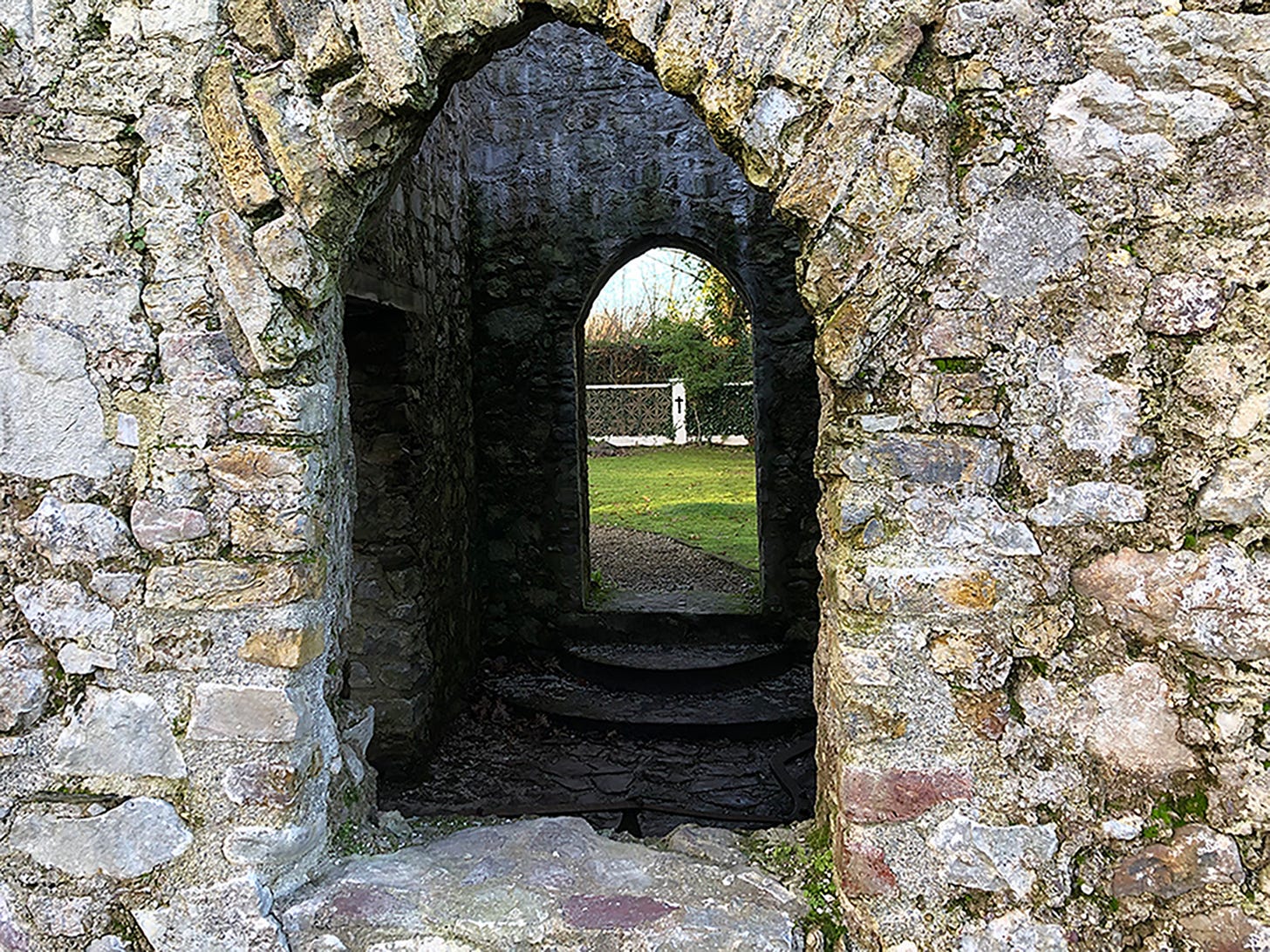

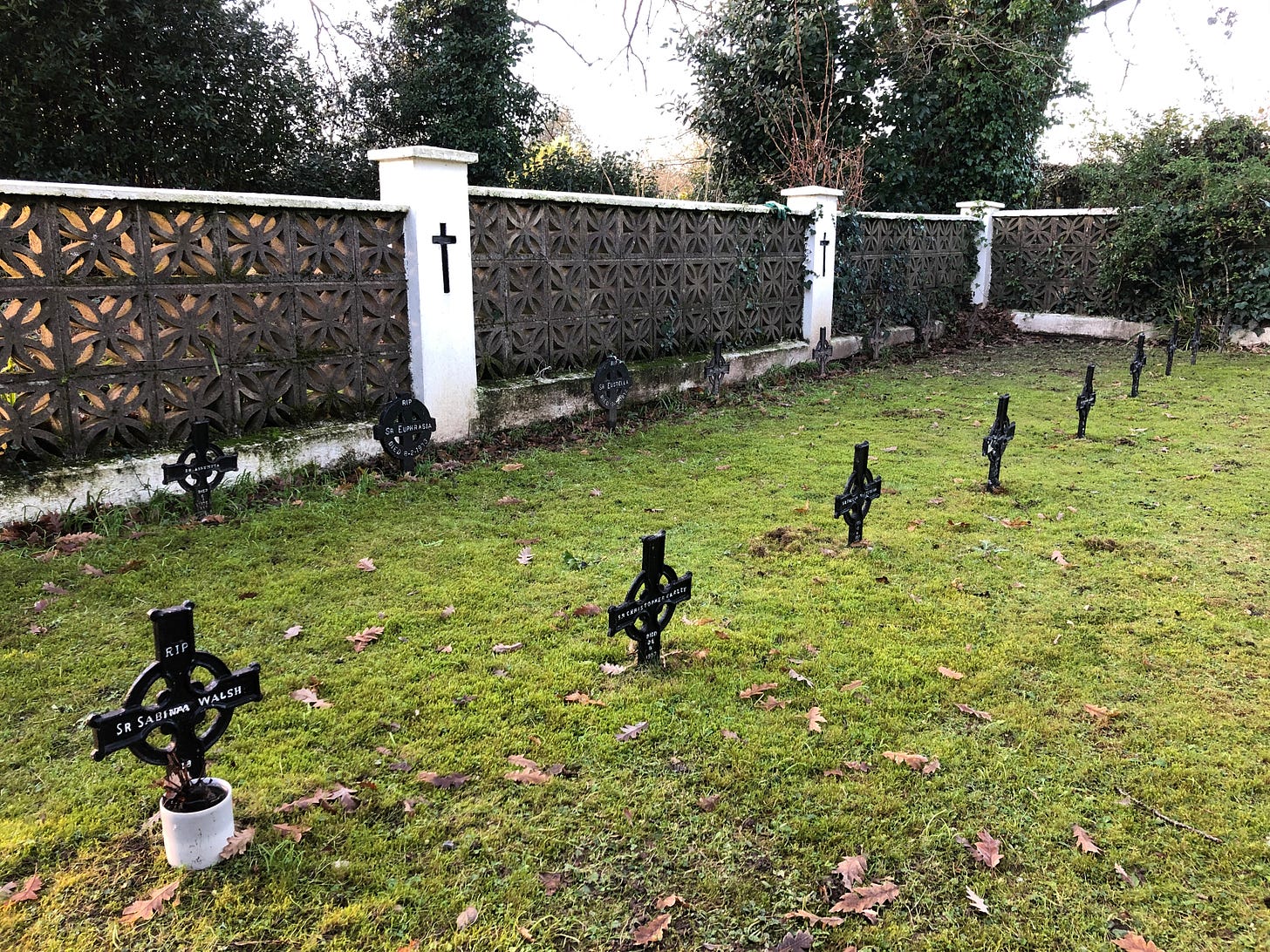

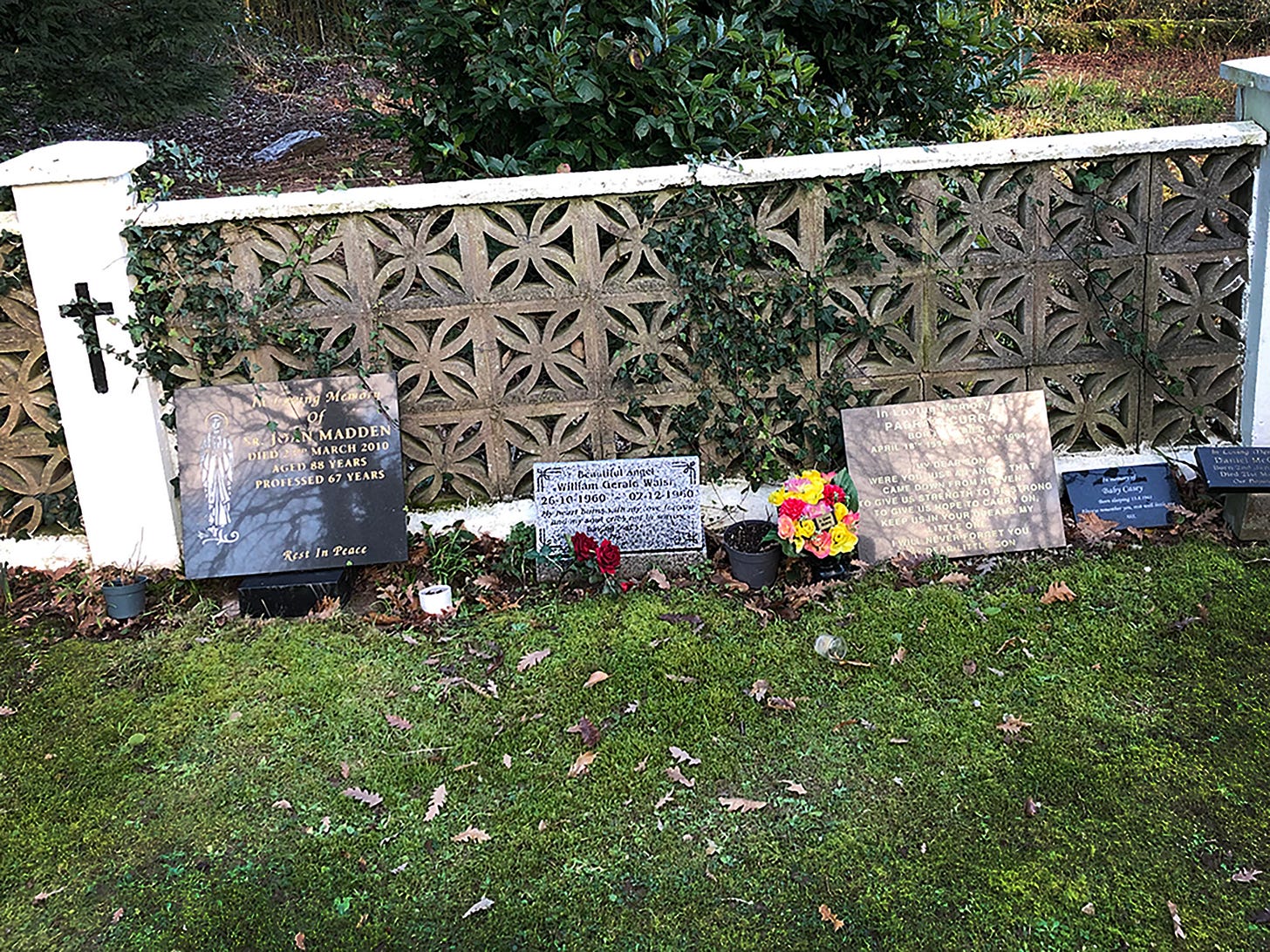
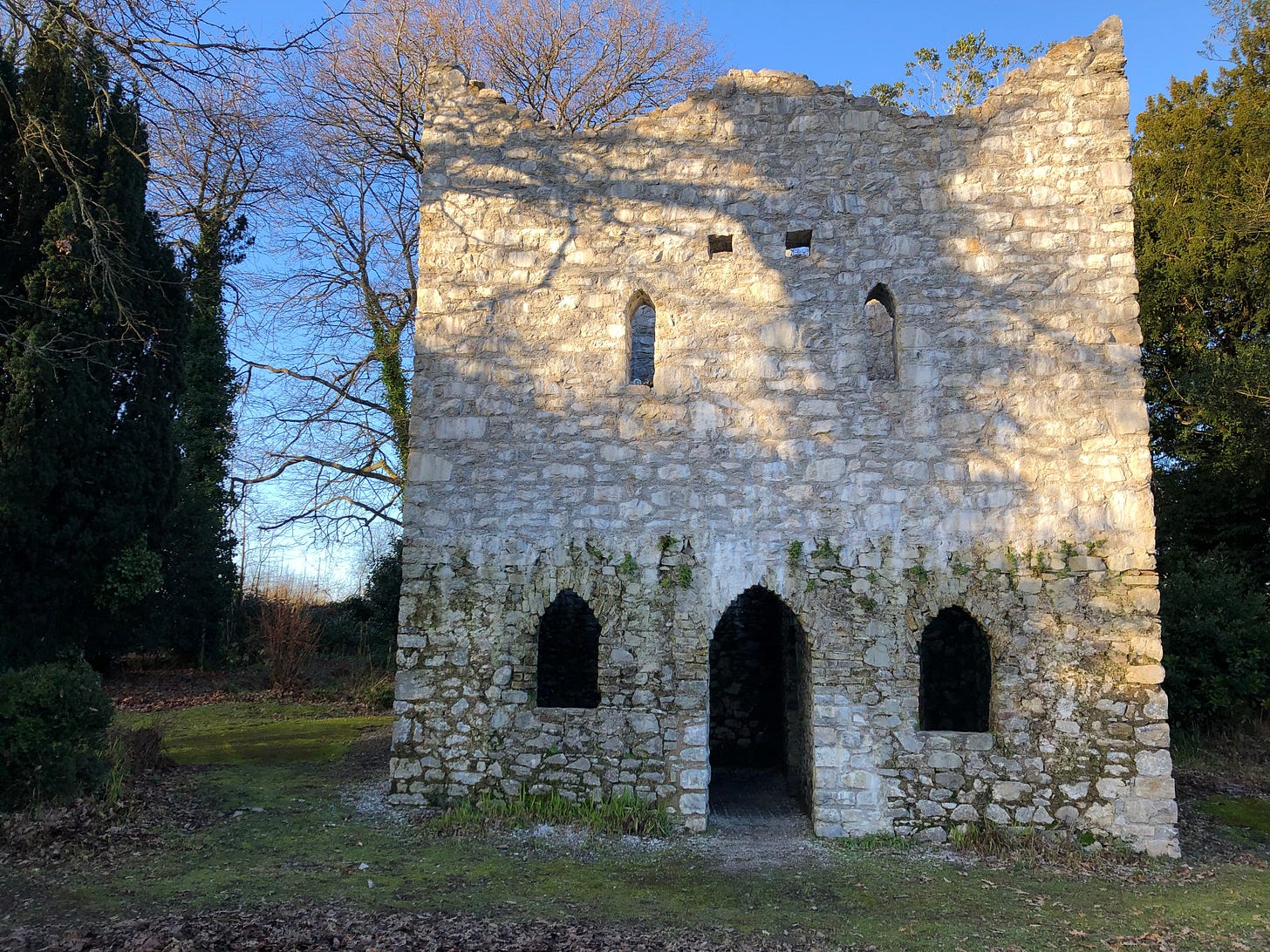
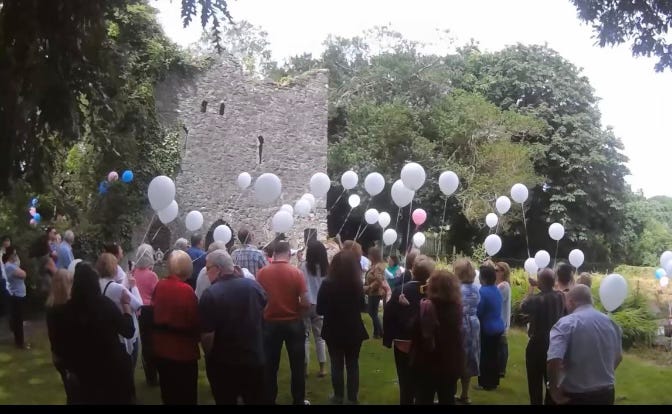
Thank you for your work on the Bessboro horror